
Welcome to the Club of Amsterdam Journal. There is no way in which to understand the world without first detecting it through the radar-net of our senses. – Diane Ackerman To live is not merely to breathe: it is to act; it is to make use of our organs, senses, faculties-of all those parts of ourselves which give us the feeling of existence. – Jacques Rousseau The faculty of imagination is both the rudder and the bridle of the senses. – Leonardo da Vinci Felix Bopp, editor-in-chief Join our Season Event about the future of Food Design on November 23! |
Food for your senses
  |
 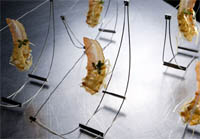 |
  |
  |
 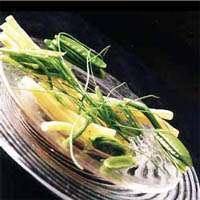 |
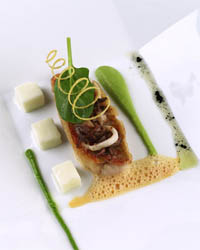  |
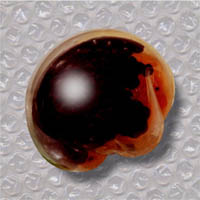 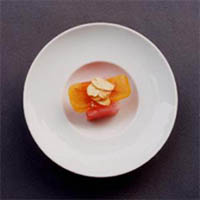 |
Visit our event about
‘the future of Food Design’
Thursday, November 23, 2006
Registration: 18:30-19:00, Conference & Food Tasting: 19:00-21:15
Where: ROC, Hotelschool, Da Costastraat 64, Amsterdam
Food Tasting is prepared by
 Masayuki Tajima food culture specialist |
Club of Amsterdam blog
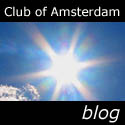 | Club of Amsterdam blog October 26: Synthesis of el Bulli cuisine October 14: The new Corinthians: How the Web is socialising journalism September 20: A Future Love Story |
News about Food Design

Scientists create high protein, low fat tortilla
A team of food researchers has been awarded a patent for a new variety of tortilla targeting consumers eager for a low fat, low carb, soy-free version of the popular bread alternative.
The scientists claim to have developed a low carbohydrate, high protein tortilla recipe with a negligible fat content of less than 0.5g of fat per 50g.
The patent allows for the production of round, thin tortillas with up to 70 per cent animal protein content, derived from either poultry, beef or fish, as an alternative to the standard corn or flour variety.
The chicken-based tortilla, used as an example in the patent, contains 2.6g of carbohydrates compared to the 23g found in flour versions and 12.6g of protein compared to flour’s 4g.This high protein content allows for a longer shelf-life and reduced microbial disintegration according to its inventors at the University of Florida’s Research Foundation.

TasteTrek by Givaudan: Discovering a new palette of flavour ingredients from around the world
From the isolated Masoala Peninsula of Madagascar to the markets and farms of Vietnam, TasteTrek teams travel the globe to discover new tastes and aromas never before used in flavour creation. TasteTrek teams explore an exotic location by setting up camp and a mini-lab in an area where there is a high probability of new discoveries – from a lush rainforest to a farm in a small village. By examining first-hand the fruits, plants, pods and herbs indigenous to a region, Givaudan scientists and flavourists identify new ingredients, new flavour experiences and important clues that lead to the creation of new molecules. TasteTrek teams also endeavour to learn local food preparations and authentic cooking techniques.
News about the Future

Understanding a traffic scenario and obeying traffic rules requires a complex form of artificial intelligence. The car that is used as a base is a stock Passat Variant 2.0 FSI. Equipped with steer-by-wire and accelerate-/brake-by-wire. It is the ideal platform for the development of autonomous vehicles.
Main sensor of the AnnieWAY is the HDL-64E, a 3-D 360 lidar specially devolped for autonomous driving and mapping applications. HD lidar is the concept of making high definition, 3 dimensional information about the surrounding environment easily available. A stereo camera system supports the lidar during normal driving (forward). Built in the Adaptive Cruise Control (ACC) is a 77GHz radar that allows the easy detection of other cars driving ahead.

The dream of a violin that can play itself has tantalized inventors for over a century. Now, modern technology has made the dream a reality – and without the use of digitally sampled sounds! Piano accompaniment can be derived from any midi source, but using Pianomation to play genuine accoustic accompaniment provides today’s ultimate listening experience in automatic music.
Next Season Event
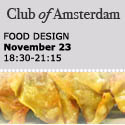 | the future of Food Design Thursday, November 23, 2006 Registration: 18:30-19:00, Conference & Food Tasting : 19:00-21:15 Where: ROC, Hotelschool, Da Costastraat 64, Amsterdam Taste, presentation of food, atmosphere, even design of food itself have existed for a long time, but they were often treated as separate elements. The contemporary awareness in design as well as in food culture enable a more holistic approach, which recently led to outstanding creative developments. This event is going to highlight three influential aspects: a) aesthetics from a consumer perspective, b) innovative food products and c) design supporting senses and a good time. 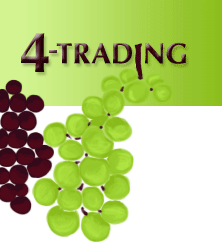 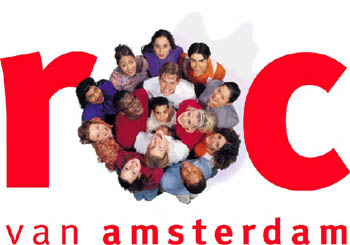  Supporter  |
Cross Cultural Competence in a Globalised World
 | Leif Thomas Olsen Assistant Professor International Relations, Rushmore University |
| The Logic of Logic – and the Role of the PremiseWhat role does culture play in international and multilateral cooperation? How can we de-mystify culture itself, and put it back on a truly multilateral track? Although culture has always been a target for debate and research do most researchers focus on specific cultures, whether social, national or political. Where social scientists in general typically study cultural phenomena, social anthropologists often study entire cultures. However, rarely is culture as a phenomenon put in focus in order to analyse the role culture plays in our daily lives in general, and the traps it provides for multilateral cooperation in particular. A parallel and equally rare debate is the one regarding the everyday link between culture and logic, and how we by exploring that link can better understand how to engage in cross-cultural interaction. In his 2001 collection of thoughts titled ‘The Meaning of Things’, A.C. Grayling wrote: Reason is merely an instrument which, correctly employed, helps people draw inferences from given premises, without inconsistency. To put this quote into a truly cultural perspective one should however consider anthropologist Melville Herskovits’ conclusion that:Given the premise, the logic is inescapable. Herskovits view, gained from a lifetime of research among African cultures, stands out as a strong advocate for a flexible view on both logic, moral and culture. From this conclusion we can also enter a discussion on what can be seen – from a more philosophical perspective – to be the components of logic, as well as the impact logic has on both conscious and sub-conscious decision-making processes. Nevertheless, as Grayling in fact referred to reason rather than logic, let us start with …. |
| Read the full article in the Summit for the Future Report 2006! |
Recommended Book

Designer Desserts
by Philippe Durand
Prestige des Grands Chefs Dessert is the grand finale of a great meal. To make a memorable lasting impression, the dessert must excite all the senses: above all it must taste delicious but it should also have texture, a lovely aroma and be beautiful to look at. A «designer dessert», which each individual serving arranged with care and purpose on an attractive plate and cleverly decorated, is a stunning way to finish a dining experience. Talented pastry chef and teacher, Philippe Durand has developed many new ideas and methods for presenting «plated desserts». He has analyzed all the components necessary for creating dazzling presentations of individual desserts arranged artistically on a plate. These innovative dishes will inspire restaurant chefs and caterers as well as home cooks who love to entertain. This book is presented in three sections. The first section illustrates the principles of style, technique and decoration necessary for the successful presentation of an individual dessert. The main part consists of dessert «formulas», grouped according to the main ingredient, along with photographs to help achieve the same stunning results. The basic recipes and techniques for making the desserts in the main section are given at the end. Restaurant chefs will find desserts to make ahead in quantity that are easily assembled to order. There are innovative ideas for combining colorful and flavorful ingredients that will inspire pastry shop owners and caterers. And for the talented home cook who wants to serve a dazzling, decorated dessert to guests, this book offers many delicious possibilities.
Horizons2020 – Thinking ahead
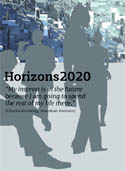 | Horizons2020 – Thinking ahead by Siemens From today’s perspective, the future has many facets. Our notions of the future are as numerous and varied as there are people on earth – at least theoretically. We will only know for sure what the future holds after it has itself become the present. |
Horizons2020 does not forecast the future. It develops space for creative thought. This space, which contains elements that can be combined into concrete visions of the future, is not static but will be adjusted over the course of the next fifteen years. As factors change, specific elements will become obsolete and new ones will be added.Horizon1 and Horizon2 are products of this set of building blocks. They start from two concrete factors and depict two variants of the future in a wide range of areas. Neither variant is preferable to the other or makes a greater claim to validity. How will things really turn out? We’ll know more in 2020.
Will the future be a golden age or an apocalypse? People have always speculated about life in the future. Siemens has begun to search for answers and, with a communications scenario called Horizons2020, to study what life will be like in the world of tomorrow. The result is a series of distinct and exciting visions of life in the year 2020. These visions challenge the imagination and invite us to reflect and think ahead.
Horizons2020 aims to foster open dialog. How do we want to live in the year 2020? How will we work and study? How will we communicate? We need to express our opinions and make decisions. The future is not going to come about by chance. How we will live tomorrow is being decided today.
At Siemens’ request, TNS Infratest interviewed experts from all across Europe about the economic, political, technological, and social developments of the next fifteen years. Horizons2020 shows how every facet of our lives may change. There are different possible outcomes. Siemens is not attempting to formulate the best forecast or predict who will be right. Instead, our goal is to draw up a complete panorama of what life may be like in the future using a solid scientific basis. We hope to create a broad scenario for 2020 and a horizon for the future.The year 2020 won’t be home to immortal human beings or flying saucers. Many of the futuristic images of Horizons2020 are both familiar and, in some respects, strange. They show reality experienced in a new way. A look at 2020 combines what is near with a view into the distance – toward a horizon where we’ll find familiar things and discover new ones.Horizons2020 sketches complex images of our lives in the future. Of how we’ll live and how we’ll work and study. Of our personal lives – our homes, our travels and our behavior as consumers. Of how we communicate. Of healthcare. And many other things. But the core question is always the same: What are the possibilities? What will life in the future look like?
The first step was to define the field of inquiry: lifeworlds in Europe in the year 2020. Next, the experts from TNS Infratest defined five factors that would decisively impact life in Europe in the year 2020. Then, using the results of the Europe-wide expert survey, TNS Infratest described these factors for the two alternative visions of the future featured in Horizon1 and Horizon2.
Politics
including governments, international relations, the organized public, the media and information
Society
including values, demographic developments, social structures, education, healthcare and mobility
Economy
including economic developments, labor markets, companies and management
Environment
including environmental awareness and foodstuffs
Technology
including general technological developments, energy technologies, information and communications technologies, gene technology, biotechnology and medical engineering
State of the Future Index
On behalf of the Millennium Project of the American Council for the United Nations University, we have the honor to invite you to participate in a study to choose variables that should compose the State of the Future Index (SOFI). This global index is designed to assess the future outlook over the next 10 years, based on 20 years or so of historical data. The global version was created in 2000 and variations have been created for several countries since then. The Millennium Project is re-assessing the SOFI’s statistical foundation to see how to improve its ability to forecast whether the future in general is getting better or worse and to identify the factors responsible. You are invited to take part in this process by providing your judgments in the on-line questionnaire.
The Millennium Project is a worldwide system for collecting, analyzing, and synthesizing judgments about emerging global challenges that may affect the human condition. Its annual State of the Future and other special reports are used by decision-makers and educators to add focus to important issues, clarify choices, and improve the quality of decisions. Since the Project’s beginning in 1996, over 2,000 people have participated in the Project’s questionnaires and interviews.
Those who participate in this study at www.realtimedelphi.com will receive the results in a complementary copy of the next edition of the State of the Future. No attributions will be made, but respondents will be listed as participants. You do not have to complete this questionnaire in one visit. When you return to the questionnaire you will see your previous answers and the inputs provided by others. You can change your previous textual and numeric answers. You are encouraged to return to this questionnaire several times before the deadline of March 1, 2007.
When you access www.realtimedelphi.com you will be asked if this is your first visit, and if so, you are requested to register (enter your email address and postal address to which we should mail the results). When you return to the questionnaire, provide just your email address (which is always your login key) and then proceed to the questionnaire. When asked to enter the access code, please enter “xsofix” if your family name begins with a letter between A – L, and “xsofiinvx ” if it is between M – Z.
Please contact us if you have any questions or need clarification about this invitation. We look forward to including your views, and to sharing the results with you.
Sincerely yours,
Jerome C. Glenn, Director, AC/UNU Millennium Project
Theodore Gordon, Senior Fellow
Agenda

| the future of Food Design November 23, 2006, 18:30 – 21:15 the future of Consciousness January 25, 2007, 18:30 – 21:15 the future of Ambient Intelligence February 22, 2007, 18:30 – 21:15 the future of Global Workplace March 29, 2007, 18:30 – 21:15 the future of Success April 26, 2007, 18:30 – 21:15 the future of Tourism May 31, 2007, 18:30 – 21:15 Taste of Diversity June 28, 2007, 18:30 – 21:15 |

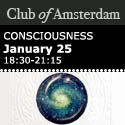
Club of Amsterdam Open Business Club
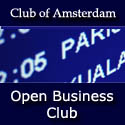 | Club of Amsterdam Open Business Club Are you interested in networking, sharing visions, ideas about your future, the future of your industry, society, discussing issues, which are relevant for yourself as well as for the ‘global’ community? The future starts now – join our online platform … |

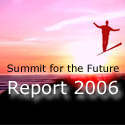



Customer Reviews
Thanks for submitting your comment!